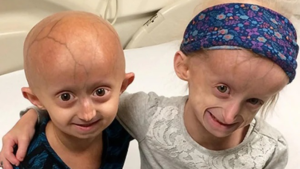What Is Progeria?
Progeria, formally known as Hutchinson-Gilford Progeria Syndrome (HGPS), is a rare genetic condition that causes children to age rapidly. The term “Progeria” is derived from the Greek word meaning “prematurely old.” But what causes a child to resemble an 80-year-old in both appearance and health? Let’s explore the science behind this mysterious syndrome.

An Overview of Hutchinson-Gilford Progeria Syndrome
Progeria is an extremely rare genetic disorder. It was first described in 1886 by Jonathan Hutchinson and later in 1897 by Hastings Gilford. The global incidence rate is approximately 1 in 4 million live births. So far, only a few hundred cases have been documented worldwide.
In 2003, researchers led by Dr. Nicolas Lévy (Marseille) and scientists from the National Institutes of Health (NIH) identified the genetic mutation responsible for the condition. Progeria is caused by a mutation in the LMNA gene, which is responsible for producing Lamin A — a protein essential for the structural integrity of a cell’s nucleus. This mutation results in a defective form of the protein, known as progerin, which disrupts normal cell function and causes cells to age prematurely.
Normally, human cells can divide a set number of times, allowing the body to replace damaged or worn-out cells. With Progeria, due to the genetic mutation, this natural process accelerates, resulting in rapid aging of the body’s tissues and organs.
The condition affects both genders equally and occurs across all races. The average life expectancy for a child with Progeria is around 13–14 years. Most do not survive beyond adolescence, though there are rare cases of individuals living into their early 20s.
Early Signs and Symptoms of Progeria
Infancy: At birth, infants with Progeria typically appear healthy. Their weight and height fall within normal ranges — around 3 kg and 50 cm respectively. The first signs of the syndrome usually emerge between 18 to 24 months, including:
- Growth delays: Significantly below-average height and weight. By age 12, a child may only be 96–128 cm tall and weigh 9.3–20.7 kg.
- Disproportionate head size: A larger-than-average head with a narrow face, small jaw, and pinched nose.
- Hair loss: Sparse hair, eyebrows, and eyelashes; often complete baldness.
- Thin, pale skin: Veins, particularly on the scalp, become visible.
- Loss of body fat: Subcutaneous fat begins disappearing around 6 months, first in limbs, then torso and eventually face.
- Delayed and abnormal tooth eruption.
- High-pitched voice.
- Tight, hardened skin (scleroderma-like changes).
- Stiff joints and reduced mobility.
As the Child Grows:
- More severe complications appear as the child ages:
- Shortness of breath.
- Hypertension (high blood pressure).
- Atherosclerosis (hardening of the arteries).
- Increased risk of heart attack or stroke.
Despite their physical challenges, children with Progeria typically have normal cognitive development. Children from diverse ethnic backgrounds affected by Progeria often exhibit remarkably similar physical appearances — especially in facial features, characterized by aged, wrinkled skin. Aging in Progeria occurs at a rate of 8–10 times faster than in normal individuals. Consequently, a 10-year-old may suffer from the same cardiovascular and musculoskeletal issues as an 80-year-old.

How Is Progeria Diagnosed?
Diagnosing Hutchinson-Gilford Progeria Syndrome can often be done through physical examination and clinical observations. However, definitive diagnosis involves genetic testing to detect the LMNA gene mutation.
Currently, this specific genetic test is not available in Vietnam. However, organizations like The Progeria Research Foundation can provide support for those seeking testing abroad.
When Progeria is suspected, doctors will perform thorough physical evaluations including:
- Measuring height and weight.
- Plotting growth curves against standard references.
- Assessing vision and hearing.
- Monitoring vital signs such as blood pressure.
- Identifying common symptoms and physical signs of Progeria.
Parents are encouraged to ask questions during the examination process. Since Progeria is extremely rare, medical professionals may need to gather detailed information before proceeding with treatment or care plans.
Is Progeria Hereditary?
Parents often wonder: If one child has Progeria, will another child also have it? Can the condition be inherited across generations?
Progeria is usually caused by a spontaneous genetic mutation, meaning it is not inherited in most cases. For parents with no family history of Progeria, the chance of having a child with the syndrome is approximately 1 in 20 million.
However, for parents who have had one child with Progeria, the risk increases slightly to 2–3%. This may be due to a condition known as mosaicism, where only a portion of the parent’s cells carry the genetic mutation — not enough to cause symptoms in the parent but sufficient to potentially affect offspring.
Prenatal genetic testing to detect LMNA gene mutations is theoretically possible, but currently unavailable in Vietnam.
Treatment Options for Progeria
Unfortunately, there is no definitive cure for Progeria. Most treatments focus on managing symptoms and reducing complications related to cardiovascular and skeletal aging.
1. Farnesyltransferase Inhibitors (FTIs)
Originally developed for cancer treatment, FTIs have shown promise in managing Progeria. They help reduce the buildup of progerin in cells. Studies show that FTIs can:
- Improve bone structure
- Increase weight gain
- Enhance blood flow
- Prolong lifespan
2. Supportive Therapies
- Low-dose aspirin: Daily doses can help prevent heart attacks and strokes.
- Physical therapy and exercise: Improve joint flexibility and maintain mobility.
- Nutritional support: High-calorie diets and supplements help prevent weight loss and support physical growth.
- Regular cardiology check-ups: Doctors may prescribe cholesterol-lowering or blood-thinning medications to prevent complications like blood clots.
Despite these interventions, the mortality rate of Progeria remains nearly 100%. Medical science has not yet discovered a fully effective treatment. However, ongoing research offers hope for future breakthroughs.
If you notice unusual signs in your child’s growth or development, don’t hesitate to consult a healthcare professional. Early detection and supportive care can make a significant difference in the quality of life for children living with Progeria.


